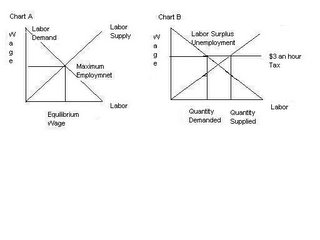To NY State Senate: Economics, Anyone...Anyone
It seems some people just never get it, unfortunately allot of the time those people are in charge of running our government. Currently Democrats in the state senate of New York are in the process of introducing a bill that would force stores with 500 or more employees to pay $3 an hour for each employee to cover health care costs for the state.
As I have written countless times on this blog over the last month, such proposals can only lead to disaster for a state like New York. Time and time again, the only thing that has been proven to maximize the amount of people in our labor force, is a free and open system that gives companies the flexibility to price their offering package to employees at the point where they can hire the most people for their money. As I have said before this is known as the Equilibrium Wage point(Chart A) which represents the point where labor supply and demand is equal on a wage and labor chart. Any microeconomics textbook will teach you that pushing wages above the equilibrium level (like forcing companies to pay $3 an hour for each employee) will raise the quantity of labor supplied (those people looking for a job) and lower the quantity of labor demanded (the amount of people that company can now hire because of the increased costs) Chart B. In simpler terms, creating wage floors through the use of minimum wage or special taxes (which is what this is) only ends up increasing unemployment in the state and worse makes other companies think twice about moving into the state or expanding within the state. As I’ve said before this has been the difference between the U.S. and Europe and why our growth rates are higher and our unemployment is lower. (Click on the graph to expand it)
One of the reasons I love economics and business is because numbers and charts don’t lie. People in our government have to get over their emotions and how they feel is the right and fair way to govern and instead govern solely on what has been proven statistically correct for centuries.

<< Home